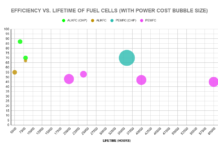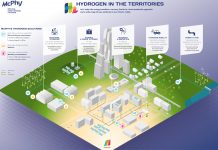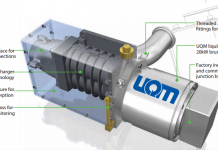About 4 or 5 years ago micro fuel cells were quite a hot topic in cleantech. They were going to power our laptops, cell phones, PDAs, blackberries, hand held multimedia devices, etc. The story ran like this: The digital age and increasing customer demand for more power hungry features like bandwidth, multimedia, et al on mobile devices like laptops, PDAs and cellphones mean the increase in power requirements are outstripping the pace of technology of lithium ion battery – therefore the only solutions will be micro fuel cells. And since battery manufacturers are a plodding, unimaginative lot, silicon valley and smart scientists can build a company to leapfrog them. We saw major players like Motorola, Toshiba, Intel, and others taking a look, and startups like Smart Fuel Cells, Medis and MTI Micro seeking to make their name on a fuel cell the size of a credit card (or thereabouts) . Today, still no micro fuel cell powered devices are on the market, many of the larger players have gone quiet, and all the startups are talking up battery charger (not device power pack) products – especially for the military and first responders. What happened? What killed the micro fuel cells? Can they come back? And is something similar lurking around the corner for solar, electric vehicles, biofuels, next generation batteries or one of today’s other darlings of the cleantech sector that we can learn from? Well . . . let’s see: The technology is actually hard – Micro fuel cell technology proved a harder nut to crack than everyone thought (at least at anywhere near the same cost point) – and the product development issues given the state of the technology proved to be a real challenge. Rational expectations – Market reaction to the underlying drivers has been aggressive. We’ve got global warming and high energy prices making people like Sun, Dell, and others hell bent on designing power saving devices – which the consumer is now interested in buying as a premium product. Once the electronic product companies actually put their minds to reducing power usage – well, it turned out that you actually CAN optimize a device to save power, and still pack enough features in to sell product. The incumbent technology – Despite high profile thermal issues, the incumbent lithium ion technology turned out not to be so bad, and has continued to keep pace (as far as us lowly consumers can tell) – Bottom line: I now carry 2 very small 4 hour battery packs for my laptop – I can last a transocean plane flight without needing to plug in. Infrastructure, infrastructure, infrastructure – And yes, having to make infrastructure changes is very costly in anything energy-esque, whether its in fuel, entrenched distribution, or tooling. As usual, winning technologies in energy tend to be owned by businesses that find a way to work with existing infrastructure, not to try and replace it. And in the end, the batteries (and the big battery makers) still rule the roost, for now. Neal Dikeman is a founding partner at Jane Capital Partners LLC, a boutique merchant bank advising strategic investors and startups in cleantech. He is founding contributor of Cleantech Blog, a Contributing Author for Inside Greentech, and a Contributing Editor to Alt Energy Stocks.







